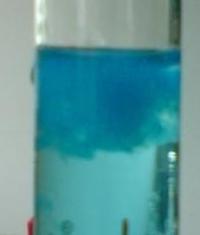Glycerin or according to the international nomenclature propanetriol -1,2,3 is a complex substance that refers to polyhydric alcohols, or rather it is a trihydric alcohol, because has 3 hydroxyl groups - OH. The chemical properties of glycerol are similar to those of monohydric alcohols, however, acidic properties are more pronounced due to the fact that there are more hydroxyl groups and they affect each other.
Glycerin, like alcohols with one hydroxyl group, is well soluble in water. This, one can say, is also a qualitative reaction to glycerin, since it dissolves in water in almost any ratio. This property is used in the production of antifreezes - liquids that do not freeze and cool the engines of cars and aircraft.
Glycerin also interacts with potassium permanganate. This is a qualitative reaction to glycerin, which is also called Scheele volcano. To carry it out, it is necessary to add 1-2 drops of anhydrous glycerol to the potassium permanganate powder, which is poured in a slide with a recess in a porcelain bowl. After a minute, the mixture spontaneously ignites with a violet flame. During the reaction, a large amount of heat is released, and hot particles of reaction products and water vapor also fly apart. This reaction is a redox.

Glycerin is hygroscopic, i.e. able to retain moisture. It is on this property that the following qualitative reaction to glycerin is based. It is carried out in a fume hood. Pour approximately 1 cm3 of crystalline potassium hydrosulfate (KHSO4) into a clean, dry tube to hold it. Add 1-2 drops of glycerin, then heating until a pungent odor appears. Potassium hydrogen sulfate acts here as a water-absorbing substance, which begins to manifest itself when heated. Glycerin, losing water, is converted to an unsaturated compound - acrolein, which has a sharp unpleasant odor. Reaction equation: C3H5 (OH) 3 - H2C = CH-CHO + 2 H2O.
The reaction of glycerol with copper hydroxide is qualitative and serves to determine not only glycerol, but also other polyhydric alcohols. In order to conduct it, initially it is necessary to prepare a fresh solution of copper hydroxide (II). To do this, add sodium hydroxide to copper sulfate and obtain copper hydroxide (II), which forms a blue precipitate. Add a few drops of glycerin to this test tube with a precipitate and notice that the precipitate disappeared and the solution turned blue.
The resulting complex is called alcoholate or copper glycerate. A qualitative reaction to glycerin with copper hydroxide (II) is used if the glycerin is in pure form or in an aqueous solution. To carry out such reactions in which glycerin is present with impurities, it is necessary to carry out a preliminary purification from them.
Qualitative reactions to glycerin help to detect it in any environment. It is actively used to determine glycerin in food, cosmetics, perfumes, medicines and antifreezes.